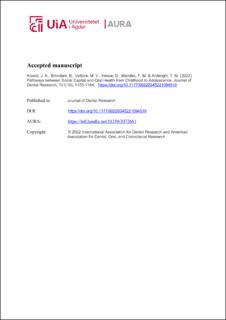| dc.contributor.author | Knorst, Jessica Klöckner | |
| dc.contributor.author | Brondani, Brunna | |
| dc.contributor.author | Vettore, Mario Vianna | |
| dc.contributor.author | Hesse, Daniela | |
| dc.contributor.author | Mendes, Fausto Medeiros | |
| dc.contributor.author | Ardenghi, Thiago Machado | |
| dc.date.accessioned | 2023-06-22T11:07:22Z | |
| dc.date.available | 2023-06-22T11:07:22Z | |
| dc.date.created | 2022-05-20T17:43:33Z | |
| dc.date.issued | 2022 | |
| dc.identifier.citation | Knorst, J. K., Brondani, B., Vettore, M. V., Hesse, D., Mendes, F. M. & Ardenghi, T. M. (2022). Pathways between Social Capital and Oral Health from Childhood to Adolescence. Journal of Dental Research, 101(10), 1155-1164. | en_US |
| dc.identifier.issn | 1544-0591 | |
| dc.identifier.uri | https://hdl.handle.net/11250/3072661 | |
| dc.description | Author's accepted manuscript | en_US |
| dc.description.abstract | This study aimed to evaluate the theoretical pathways by which social capital can influence dental caries and oral health–related quality of life (OHRQoL) of children over time. This 10-y prospective cohort started in 2010 with a sample of 639 preschoolers aged 1 to 5 y from the southern Brazil. Community and individual social capital were assessed at baseline through the presence of formal institutions in the neighborhood and social networks, respectively. In the 10-y follow-up, the individual social capital was evaluated by social trust and social networks. Dental caries was measured by the International Caries Detection and Assessment System (ICDAS), and the short version of the Child Perception Questionnaire (CPQ11-14) was used to assess OHRQoL. Demographic, socioeconomic, behavioral (frequency of toothbrushing and use of dental services), and psychosocial (sense of coherence) characteristics were also assessed. Structural equation modeling was used to evaluate the associations between variables over time. About 429 children were reassessed at 10-y follow-up (67.1% cohort retention rate). High community social capital at baseline directly predicted lower occurrence of dental caries and better OHRQoL after 10 y. Social capital at community level also indirectly predicted lower occurrence of dental caries through sense of coherence, frequency of toothbrushing, and use of dental services. Individual social capital at follow-up was indirectly linked to OHRQoL via the psychosocial pathway (sense of coherence). Community-level social capital was associated with dental caries and OHRQoL over time. The relationship between individual social capital and oral health was mediated through the psychosocial pathway. | en_US |
| dc.language.iso | eng | en_US |
| dc.publisher | Sage Publications | en_US |
| dc.rights | Attribution-NonCommercial-NoDerivatives 4.0 Internasjonal | * |
| dc.rights.uri | http://creativecommons.org/licenses/by-nc-nd/4.0/deed.no | * |
| dc.title | Pathways between Social Capital and Oral Health from Childhood to Adolescence | en_US |
| dc.type | Peer reviewed | en_US |
| dc.type | Journal article | en_US |
| dc.description.version | acceptedVersion | en_US |
| dc.rights.holder | © 2022 International Association for Dental Research and American Association for Dental, Oral, and Craniofacial Research | en_US |
| dc.subject.nsi | VDP::Medisinske Fag: 700 | en_US |
| dc.source.pagenumber | 1155-1164 | en_US |
| dc.source.volume | 101 | en_US |
| dc.source.journal | Journal of Dental Research | en_US |
| dc.source.issue | 10 | en_US |
| dc.identifier.doi | https://doi.org/10.1177/00220345221094510 | |
| dc.identifier.cristin | 2026105 | |
| dc.relation.project | Fundação de Amparo à Pesquisa do Estado do Rio Grande do Sul: FAPERPGS—process 17/2551-0001083-3 | en_US |
| dc.relation.project | The Conselho Nacional de Desenvolvimento Científico e Tecnológico: CNPq—process 160258/2020-0 | en_US |
| cristin.qualitycode | 2 | |

